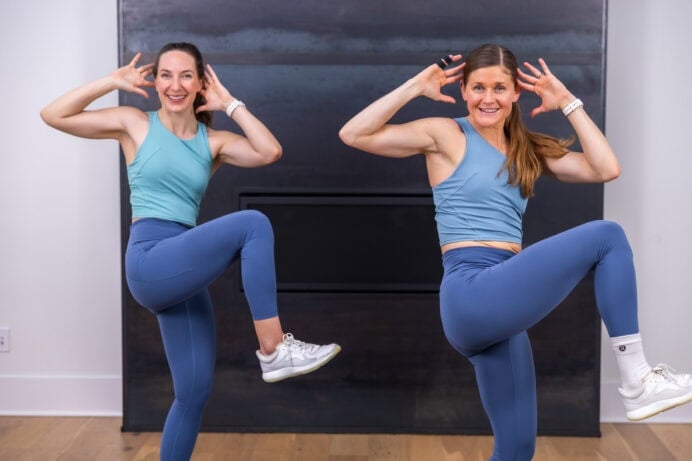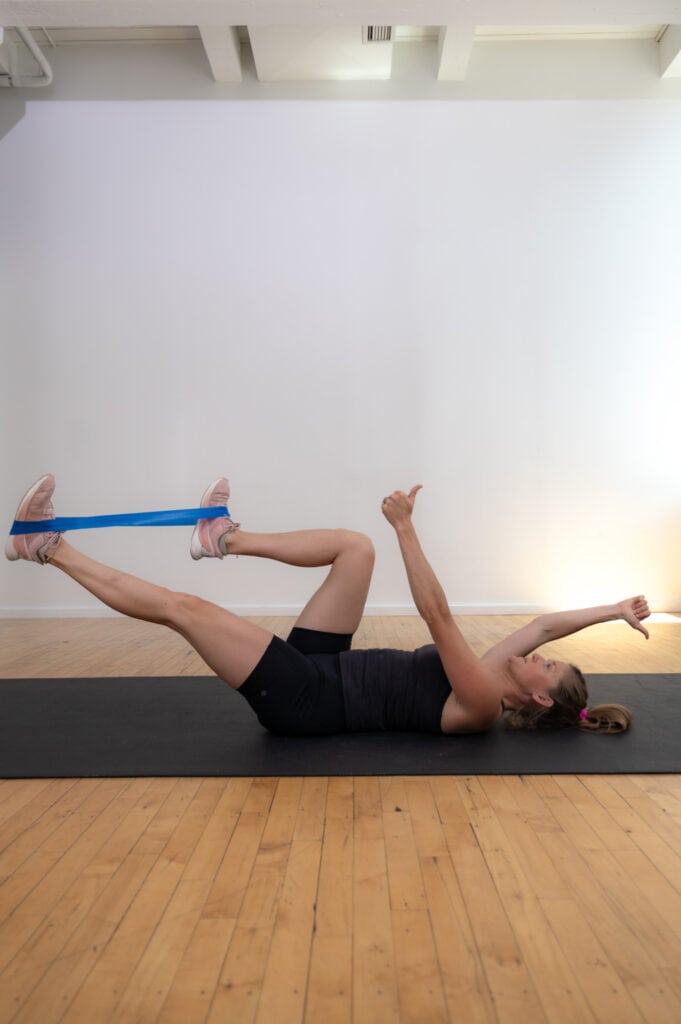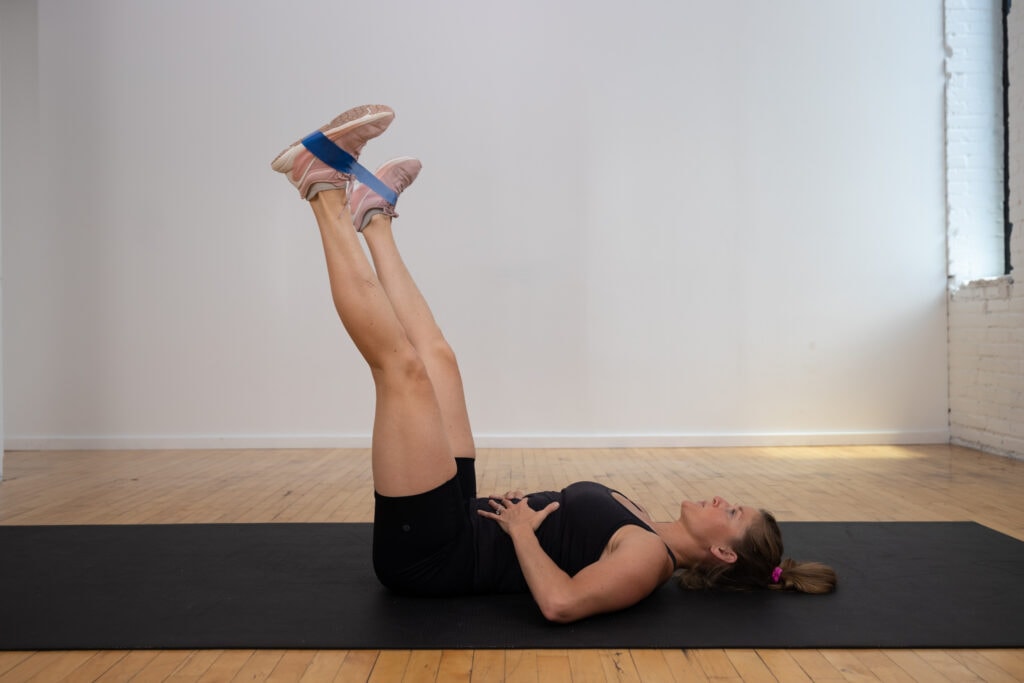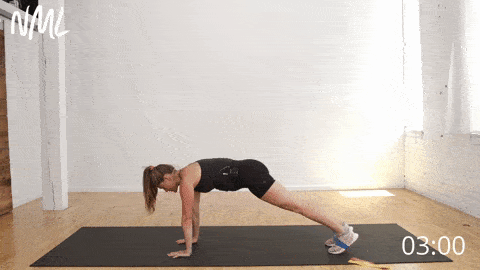 Buy Now →
Buy Now → 

Repair diastasis recti and increase core strength after pregnancy with this home workout: the best postpartum ab exercises for moms. Add this to your workout routine to repair abdominal separation after pregnancy, strengthen the pelvic floor and hips, and build core strength. This postpartum core workout uses a mini resistance band to target the deep core muscles, but you can perform the moves with just your bodyweight if you don’t have one available.
This is the fourth (and final) installment of our Advanced Diastasis Recti Workout Videos. So far we’ve shared an advanced bodyweight workout, advanced pilates ball workout and advanced long loop resistance band – and you’ve asked for more.
Today’s workout adds in a mini loop resistance band to increase tension and strengthen the core post pregnancy. This is one of my favorite tools to help make the mind-muscle connection necessary to start repairing diastasis recti.
Don’t have a resistance band? You can substitute an old sports bra or perform the moves with just your bodyweight.

Diastasis recti is common in women who have experienced pregnancy. Diastasis recti occurs when the rectus abdominis muscles (six-pack ab muscles) and linea alba (connective tissue) separate as your belly grows during pregnancy. This ab separation can range from mild to severe.
Every postpartum healing experience is different. Talk to your doctor or midwife for medical clearance before returning to exercise after giving birth, especially if you had any complications. I personally started doing the beginner version of exercises like this one around 2 weeks postpartum and scaled up to the advanced version a few weeks later. Start where you are and do what you can!
If it’s an option available to you, I recommend this to everyone who’s been through a pregnancy. I learned so much about my body from my sessions with Dr. Sari (Motion MN). Other reasons to see a pelvic floor PT include symptoms like bladder control/urinary incontinence or fecal incontinence, urinary or fecal urgency, heaviness/pressure, pain or fear with return to intercourse, constipation or issues with bowel movements, or just wanting guidance with return to exercise and strengthening your core.

Strengthen and tone your abs after pregnancy with these postpartum abdominal exercises.
These resistance band ab exercises are specifically designed to heal diastasis recti, strengthen the pelvic floor and glutes, and rebuild your core strength after baby. That said, this is a challenging ab workout for everyone.
Add this diastasis recti workout to your postpartum workout routine as you feel capable, starting with 1-2 times a week and scaling up to 3-4 times a week. I recommend alternating this workout with our other diastasis recti workout videos to avoid workout boredom.
A mini loop resistance band or “booty band”. You can use a sports bra or just your bodyweight if you don’t have a band available.

Follow along with the guided Advanced Mini Band Ab Workout on YouTube, led by certified personal trainer and certified postnatal fitness instructor, Lindsey Bomgren.
Your Workout Looks Like This:

Targets: Deep transverse abdominal muscles (TVA), lower abs, hips and chest.

Modification: Reduce range of motion to reduce the intensity. You can keep bends in both knees rather than kicking straight out to scale this exercise as well.
Targets: Transverse abdominal muscles (deep core muscles below your rectus abdominis muscle or six pack ab muscles), lower abs, inner thighs and hip flexors.

Modification: Reduce range of motion of your legs, performing bent leg dead bugs instead of straight leg dead bugs to reduce the intensity of this exercise.
Targets: Deep core muscles (transverse abdominis), lower abs, gluteus medius (the outer part of your butt used for side-to-side movements), and hips.

Modification: Shorten the range of motion by placing the band six inches above your knees (on the thighs) and perform this same movement with legs bent at 90 degrees.
Targets: Upper abs, lower abs, obliques, transverse abdominal muscles, shoulders and back.

Modification: Take the plank from an incline (a chair or couch works great) to reduce the intensity.
Targets: Gluteus medius (which lays on the outer edge of the buttocks and is responsible for stabilizing your pelvis), gluteus minimus (hip extension), obliques and core.
Clam shell exercises can help balance the muscular effort between your inner and outer thighs and your pelvic floor.

 Buy Now →
Buy Now →  Buy Now →
Buy Now →  Buy Now →
Buy Now →  Buy Now →
Buy Now → 
This post includes affiliate links. I do earn a commission for products purchased using these links (at no additional cost to you). Thank you for supporting Nourish Move Love, making the content you see on this blog possible.
Thanks for this great ab workout! I am almost 14 years post-partum 😉 , and it was still a terrific ab add-on to the WOD. It feels good to do the slow and careful work coordinated with the breath and to really feel the muscles working!
Sarah! So glad you loved this ab workout — a great one to come back to! And a great add-on to any workout! Nice work! -Lindsey